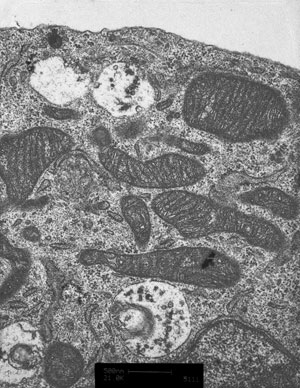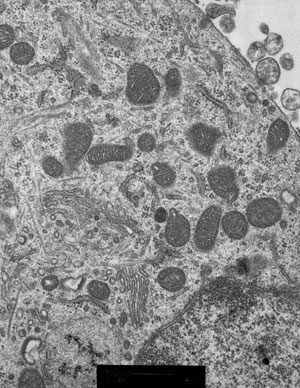The Crossin Laboratory
Research
Mitochondria and Neural Stem Cells
Neurons are high energy-requiring cells and thus are critically dependent on aerobic metabolism. Our studies on stem cells from embryonic rat cortex revealed that levels of several mitochondrial proteins increase upon NSC differentiation into neurons. Moreover, the neurons had higher levels of reactive oxygen species (ROS) than did the NSCs from which they were derived. This finding provided a means to prepare highly purified NSCs and neurons using FACS and ROS-sensitive dyes. Given that ROS are a natural byproduct of aerobic (i.e. mitochondrial) respiration, this observation focused our attention on mitochondrial composition and function as a possible driving force for neuronal differentiation.
Projects extending these observations focus on comparing mitochondrial composition and activity in NSCs and various neuronal types, and the role of mitochondrial fission and fusion in modulating these processes.


Influence of Oxygen Levels on Neural Stem Cell Proliferation and Differentiation
Studies from our laboratory and several others have indicated that stem cell proliferation is enhanced and differentiation can be modulated when oxygen levels are lower than the 20% typically used in cell culture. Lower levels of oxygen are in fact physiological because the range of O2 levels measured in tissues ranges from 0.1 to 9%, in brain from 0.1 to 5%, and oxygen levels observed in the neural stem cell niche in vivo are among the lowest. Our recent studies have shown that matrix metalloproteinase MMP9 was increased in NSCs in 1% O2. MMP9 activity was responsible for the increased growth rate of these cells in 1% O2 over 20% O2, as blockade of MMP9 activity with a specific inhibitor completely prevented the increase in proliferation.
Lowered oxygen also caused alterations in levels of mRNA for several cell and substrate adhesion molecules and appeared to affect cell adhesion and possibly cell migration early in the differentiation process. In 1% O2, the production of actin-rich protrusions in neurons was stimulated. The major effect of lowered oxygen in cortical neural stem cell cultures appears to be a shift in the balance between cell and substrate adhesion.
Additional studies will clarify the effects of lowered O2 and MMP9 inhibition on cell adhesion and migration during both the growth and differentiation phases of culture. In addition, we are evaluating changes in migration and differentiation under high and low oxygen environments. Levels of adhesion and ECM molecules found to be altered by lower O2 will be assessed in the presence and absence of MMP9 inhibitors to determine which adhesion systems contribute to the observed effects on proliferation and differentiation.
Given that low O2 levels are consistent with the stem cell niche in vivo, the molecules found to be altered in lower oxygen need to be examined in developing embryos from wild type animals and transgenic animals in which such molecules have been perturbed.

